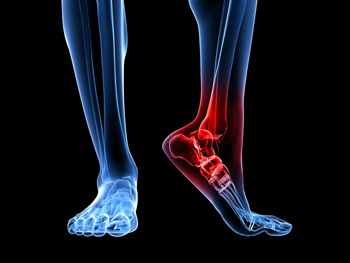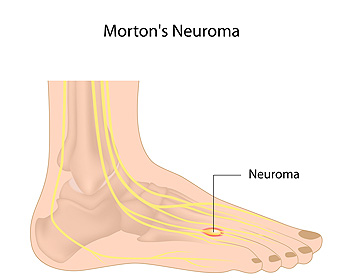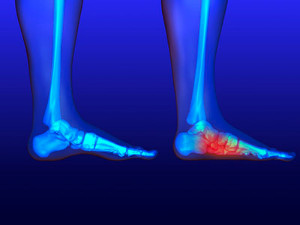Connect With Us
Blog
Items filtered by date: July 2021
Issues That May Cause Heel Pain
 The heel bone is the largest bone in the foot, and it absorbs most of the impact when walking or running. Because of this, heel pain can cause a variety of problems that impact daily life. Plantar fasciitis is the leading cause of heel pain, and this is a result of the band of tissue that runs along the bottom of the foot (known as the plantar fascia) becoming inflamed or torn. Another source of heel pain is known as Achilles tendonitis. This occurs when the Achilles tendon, which connects the heel bone to the calf muscle, becomes inflamed or begins to degenerate. Bone spurs can also lead to heel pain. These are formed when calcium builds up on the bone, and they generally occur at the back of the heel. Other common sources of heel pain can include heel bone fractures, bursitis, tarsal tunnel syndrome, and Sever’s disease. If you are struggling with heel pain, consulting with a podiatrist is important in order to get a proper diagnosis and treatment for your condition.
The heel bone is the largest bone in the foot, and it absorbs most of the impact when walking or running. Because of this, heel pain can cause a variety of problems that impact daily life. Plantar fasciitis is the leading cause of heel pain, and this is a result of the band of tissue that runs along the bottom of the foot (known as the plantar fascia) becoming inflamed or torn. Another source of heel pain is known as Achilles tendonitis. This occurs when the Achilles tendon, which connects the heel bone to the calf muscle, becomes inflamed or begins to degenerate. Bone spurs can also lead to heel pain. These are formed when calcium builds up on the bone, and they generally occur at the back of the heel. Other common sources of heel pain can include heel bone fractures, bursitis, tarsal tunnel syndrome, and Sever’s disease. If you are struggling with heel pain, consulting with a podiatrist is important in order to get a proper diagnosis and treatment for your condition.
Many people suffer from bouts of heel pain. For more information, contact Scott Matthews, DPM, MD of Salem Foot Care . Our doctor can provide the care you need to keep you pain-free and on your feet.
Causes of Heel Pain
Heel pain is often associated with plantar fasciitis. The plantar fascia is a band of tissues that extends along the bottom of the foot. A rip or tear in this ligament can cause inflammation of the tissue.
Achilles tendonitis is another cause of heel pain. Inflammation of the Achilles tendon will cause pain from fractures and muscle tearing. Lack of flexibility is also another symptom.
Heel spurs are another cause of pain. When the tissues of the plantar fascia undergo a great deal of stress, it can lead to ligament separation from the heel bone, causing heel spurs.
Why Might Heel Pain Occur?
- Wearing ill-fitting shoes
- Wearing non-supportive shoes
- Weight change
- Excessive running
Treatments
Heel pain should be treated as soon as possible for immediate results. Keeping your feet in a stress-free environment will help. If you suffer from Achilles tendonitis or plantar fasciitis, applying ice will reduce the swelling. Stretching before an exercise like running will help the muscles. Using all these tips will help make heel pain a condition of the past.
If you have any questions please contact our office located in Wikesboro, NC . We offer the newest diagnostic and treatment technologies for all your foot and ankle needs.
Are Ankle Sprains Serious?
Ankle sprains occur when the ligaments in your ankle become torn or stretched. Although sprains are very common, they can lead to additional sprains and long-term ankle weakness and joint pain if they are not treated and do not heal properly. Typically, ankle sprains occur when a sudden movement causes the ankle to roll outwardly, and overly stretch or tear the outside ligaments. Depending on how badly the ligaments have been damaged, ankle sprains can range from mild (mobility and little-to-no-pain) to severe (lack of mobility and instability in the ankle). You may notice immediate pain, swelling and bruising at the site of the sprain and, in more serious sprains, a pop or snap may be heard and/or felt. If you believe you may have sprained your ankle, seek the professional care of a podiatrist in order to be diagnosed and treated properly.
Ankle sprains are common but need immediate attention. If you need your feet checked, contact Scott Matthews, DPM, MD from Salem Foot Care . Our doctor can provide the care you need to keep you pain-free and on your feet.
How Does an Ankle Sprain Occur?
Ankle sprains take place when the ligaments in your ankle are torn or stretched beyond their limits. There are multiple ways that the ankle can become injured, including twisting or rolling over onto your ankle, putting undue stress on it, or causing trauma to the ankle itself.
What Are the Symptoms?
- Mild to moderate bruising
- Limited mobility
- Swelling
- Discoloration of the skin (depending on severity)
Preventing a Sprain
- Wearing appropriate shoes for the occasion
- Stretching before exercises and sports
- Knowing your limits
Treatment of a Sprain
Treatment of a sprain depends on the severity. Many times, people are told to rest and remain off their feet completely, while others are given an air cast. If the sprain is very severe, surgery may be required.
If you have suffered an ankle sprain previously, you may want to consider additional support such as a brace and regular exercises to strengthen the ankle.
If you have any questions please feel free to contact our office located in Wikesboro, NC . We offer the newest diagnostic and treatment technologies for all your foot and ankle needs.
Understanding Morton’s Neuroma
A neuroma is a condition where the tissue that surrounds a nerve becomes thickened and inflamed. A neuroma can materialize around any nerve of the body, but when it occurs between the 3rd and 4th toes (or less commonly the 2nd and 3rd toes), it is known as Morton’s Neuroma. This benign growth of nerve cells can cause tingling, pain, and numbness in the ball of the foot—often making it feel as if there is a pebble stuck in your shoe. It is suggested that you see a podiatrist if you suspect you have Mortaon’s neuroma, as the condition may worsen and possibly lead to permanent nerve damage.
Morton’s neuroma is a very uncomfortable condition to live with. If you think you have Morton’s neuroma, contact Scott Matthews, DPM, MD of Salem Foot Care . Our doctor will attend to all of your foot care needs and answer any of your related questions.
Morton’s Neuroma
Morton's neuroma is a painful foot condition that commonly affects the areas between the second and third or third and fourth toe, although other areas of the foot are also susceptible. Morton’s neuroma is caused by an inflamed nerve in the foot that is being squeezed and aggravated by surrounding bones.
What Increases the Chances of Having Morton’s Neuroma?
- Ill-fitting high heels or shoes that add pressure to the toe or foot
- Jogging, running or any sport that involves constant impact to the foot
- Flat feet, bunions, and any other foot deformities
Morton’s neuroma is a very treatable condition. Orthotics and shoe inserts can often be used to alleviate the pain on the forefront of the feet. In more severe cases, corticosteroids can also be prescribed. In order to figure out the best treatment for your neuroma, it’s recommended to seek the care of a podiatrist who can diagnose your condition and provide different treatment options.
If you have any questions, please feel free to contact our office located in Wikesboro, NC . We offer the newest diagnostic and treatment technologies for all your foot care needs.
What Is the Difference Between Flat Feet and High Arches?
Feet come in many different shapes and sizes, and so do their arches. The arch is the curved area that is located along the bottom of the foot, roughly at the foot’s center. Not everyone is born with and arch and not everyone develops an arch. Many people have flat feet, where their arch is not visible, either all the time or just while bearing weight. Flat feet are common and can be present from birth or acquired later in life. Flat feet may cause foot pain or a dysfunctional walking pattern, but in many cases, they are asymptomatic. High arches are a rarer occurrence where the arches are unusually raised. High arches may cause pain while going about your daily activities and make it harder to find shoes that fit comfortably. If you have flat feet or high arches that are bothering you, it is suggested that you seek the care of a podiatrist.
Flatfoot is a condition many people suffer from. If you have flat feet, contact Scott Matthews, DPM, MD from Salem Foot Care . Our doctor will treat your foot and ankle needs.
What Are Flat Feet?
Flatfoot is a condition in which the arch of the foot is depressed and the sole of the foot is almost completely in contact with the ground. About 20-30% of the population generally has flat feet because their arches never formed during growth.
Conditions & Problems:
Having flat feet makes it difficult to run or walk because of the stress placed on the ankles.
Alignment – The general alignment of your legs can be disrupted, because the ankles move inward which can cause major discomfort.
Knees – If you have complications with your knees, flat feet can be a contributor to arthritis in that area.
Symptoms
- Pain around the heel or arch area
- Trouble standing on the tip toe
- Swelling around the inside of the ankle
- Flat look to one or both feet
- Having your shoes feel uneven when worn
Treatment
If you are experiencing pain and stress on the foot you may weaken the posterior tibial tendon, which runs around the inside of the ankle.
If you have any questions please feel free to contact our office located in Wikesboro, NC . We offer the newest diagnostic and treatment technologies for all your foot and ankle needs.
Blog Archives
- April 2025
- March 2025
- February 2025
- January 2025
- December 2024
- November 2024
- October 2024
- September 2024
- August 2024
- July 2024
- June 2024
- May 2024
- April 2024
- March 2024
- February 2024
- January 2024
- December 2023
- November 2023
- October 2023
- September 2023
- August 2023
- July 2023
- June 2023
- May 2023
- April 2023
- March 2023
- February 2023
- January 2023
- December 2022
- November 2022
- October 2022
- September 2022
- August 2022
- July 2022
- June 2022
- May 2022
- April 2022
- March 2022
- February 2022
- January 2022
- December 2021
- November 2021
- October 2021
- September 2021
- August 2021
- July 2021
- June 2021
- May 2021
- April 2021
- March 2021
- February 2021
- January 2021
- December 2020
- November 2020
- October 2020
- September 2020
- August 2020
- July 2020
- June 2020
- May 2020
- April 2020
- March 2020
- February 2020
- January 2020
- December 2019
- November 2019
- October 2019
- September 2019
- August 2019
- July 2019
- June 2019
- May 2019
- April 2019
- March 2019
- February 2019
- January 2019
- December 2018
- November 2018
- October 2018
- September 2018
- August 2018
- July 2018
- June 2018
- May 2018




